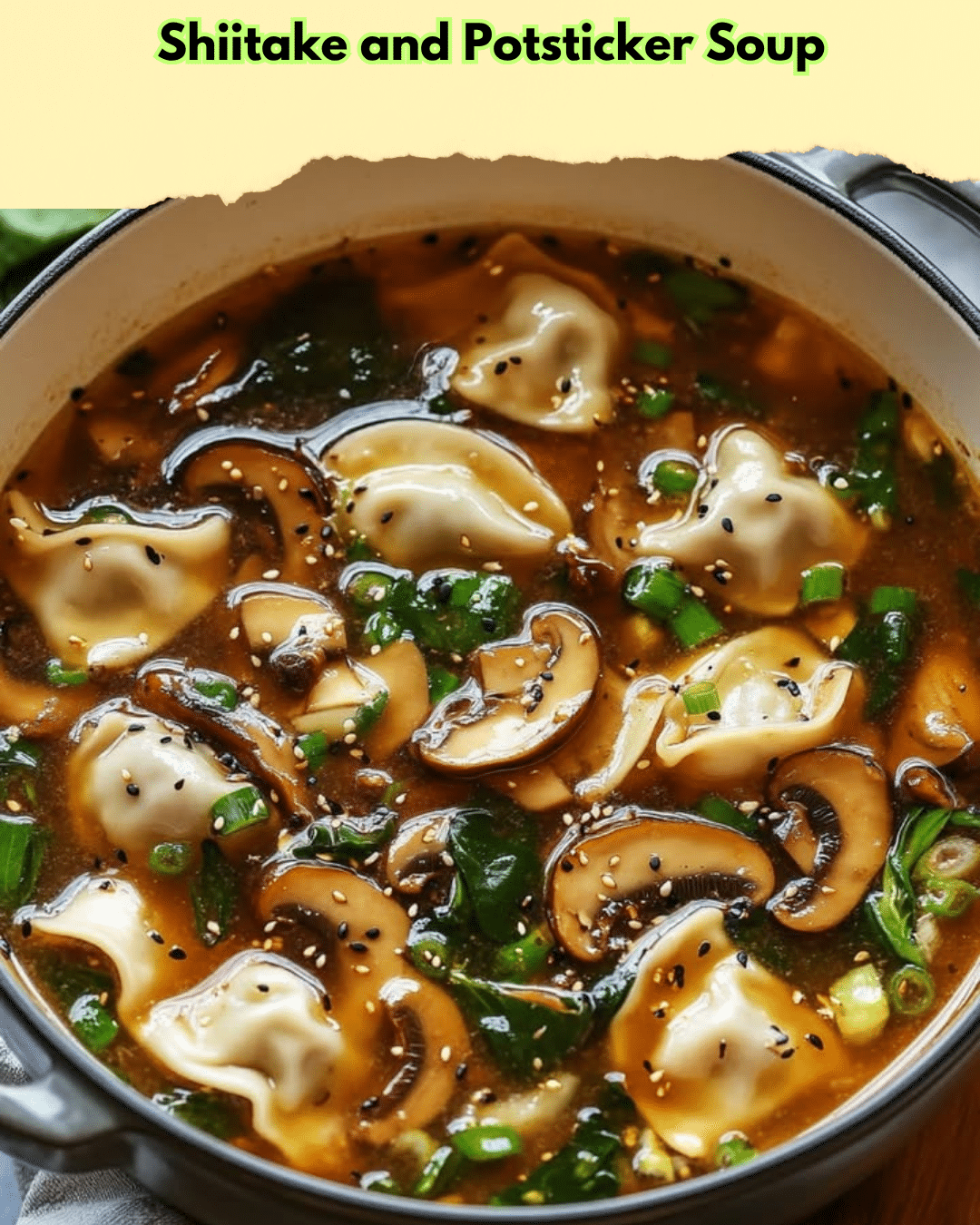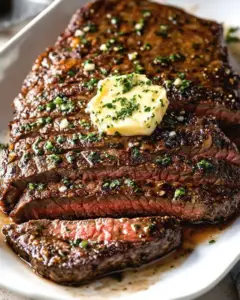Shiitake and Potsticker Soup: A Warming Delight
Welcome to a world of comforting flavors with our Shiitake and Potsticker Soup. This soup is a delightful harmony of earthy shiitake mushrooms and savory potstickers, creating an irresistible broth that warms both body and soul. Perfect for a cozy dinner at home, this recipe combines simplicity with rich taste, ensuring even beginners can achieve a satisfying outcome. The blend of shiitake mushrooms boosts the umami flavor profile, while the potstickers add a hearty texture that makes this soup a complete and fulfilling meal.
Quick Recipe Highlights
- Flavor Profile: The shiitake mushrooms bring a robust, savory depth, complemented by the slightly spicy undertones from optional chili oil, creating a perfect balance of intricate and comforting flavors.
- Texture: The combination of tender mushrooms and soft, chewy potstickers offers a delightful contrast, making each spoonful a textural journey.
- Aroma: As the soup simmers, it fills your kitchen with the rich scent of shiitake mushrooms and ginger, promising the comforting warmth of homemade goodness.
- Visual Appeal: A vibrant broth adorned with fresh cilantro and green onions, enhanced by the floating dumplings, makes this soup as appealing to the eyes as it is to the palate.
- Skill Level Needed: This recipe is perfect for all skill levels, requiring basic cooking techniques primarily involving boiling and simmering.
- Special Equipment: A large pot and a ladle are all the equipment needed to prepare this comforting soup.
Recipe Overview
- Difficulty Level: Reasonably straightforward, this soup only requires basic chopping and boiling techniques. Suitable for novice cooks looking to build kitchen confidence with a rewarding dish.
- Category: This dish falls under the soup and stew category, providing a hearty meal option that can be served as either an appetizer or the main course.
- Cuisine: Influenced by Asian culinary traditions, this soup demonstrates the simplicity and depth of flavors characteristic of East Asian comfort food.
- Cost: Reasonably economical, the main ingredients like shiitake mushrooms and potstickers are affordable, making this dish budget-friendly.
- Season: Perfect for autumn and winter, this warming soup provides a comforting dish to enjoy during cooler months.
- Occasion: Ideal for weeknight dinners or casual gatherings, this dish offers both nourishment and satisfaction in a single bowl.
Why You’ll Love This Recipe
The Shiitake and Potsticker Soup is sure to impress with a rich and deep taste that satisfies the palate. The combination of earthy mushrooms with savory dumplings crafts a full-bodied soup that feels both delicate and hearty. The tender texture of the potstickers contrasts beautifully with the mushrooms, creating an enjoyable textural variety with every mouthful.
Beyond its appealing flavor, the convenience of this recipe lies in its ease of preparation. Taking less than 40 minutes from start to finish, it fits perfectly into a busy schedule without sacrificing taste. This soup allows you to enjoy an authentic home-cooked meal in little time by using readily available ingredients.
Nutritionally, this soup is a winner. The shiitake mushrooms offer a boost of vitamins D and B, while potstickers contribute protein, ensuring each bowl is packed with essential nutrients. By opting for low-sodium broth, you can further enhance its health benefits without compromising on flavor.
Socially, this dish is a crowd-pleaser. It’s perfect for sharing with friends and family, and it’s an excellent choice for potlucks or gatherings. The versatility and flavor profile allow it to pair well with numerous dishes, ensuring it complements a variety of menu plans.
The affordability and accessibility of the ingredients make this soup a cost-effective choice that doesn’t skimp on quality. Shiitake mushrooms and potstickers can be purchased at most grocery stores, offering a gourmet meal experience within a reasonable budget.
Historical Background and Cultural Significance
The Shiitake and Potsticker Soup draws its inspiration from traditional Asian cuisine, emphasizing simplicity paired with deep flavors. Shiitake mushrooms have long been used in Eastern Asia due to their umami qualities, adding a depth of flavor to soups and broths for centuries. Originating from East Asia, the use of these mushrooms symbolizes the region’s reverence for natural, earthy tastes in cooking.
Culturally, potstickers have a rich history as a staple in Chinese cuisine. Often served during social gatherings and celebratory occasions, they represent harmony and family connection. Combined with the shiitake mushrooms, this soup demonstrates a perfect blend of cultural traditions celebrated across Asian culinary contexts.
Throughout its evolution, this dish has seen variations across different regions. While the core ingredients remain the same, modifications such as adding different local herbs or spices highlight the adaptability of this cherished recipe. This flexibility showcases the global appeal of the dish, resonating with home cooks and professional chefs alike.
Regional variations of this soup further express its ability to adapt to available ingredients, resulting in local twists showcasing regional produce. Whether slightly spicy with added chilies in Taiwan or milder with additional broth in Japan, the Shiitake and Potsticker Soup thrives across diverse cooking environments.
Ingredient Deep Dive
Shiitake mushrooms, native to East Asia, have been cultivated for their unique flavor and health benefits for thousands of years. Used extensively in many Asian dishes, they are renowned for their deep and meaty umami taste, enhancing the flavors of any dish. Known as a powerhouse of nutrients, shiitake mushrooms provide an excellent source of vitamins, including vitamin D, and possess various health-boosting properties such as immune enhancement.
Selecting the right shiitake mushrooms is key; fresh shiitakes should have firm caps without blemishes. For longer storage, keep mushrooms refrigerated in a paper bag to maintain freshness. If fresh mushrooms are unavailable, dried shiitakes serve as a worthy substitute, though they will require rehydration before cooking.
Potstickers, or dumplings, have become a celebrated component in many Asian cultures. With a filling often composed of meat and vegetables, they encapsulate flavorful richness within a tender dough wrapper. Potstickers not only add protein to the dish but also a delightful contrast in texture compared to the shiitake mushrooms.
To ensure quality, selecting potstickers with intact wrappers is essential. Frozen potstickers should be stored appropriately in their packaging until ready for use. If desired, substituting homemade dumplings can tailor the dish to specific dietary preferences, empowering creativity in the kitchen.
Common Mistakes to Avoid
- Overcooking the potstickers can make them fall apart; be sure to add them towards the end of the cooking process to maintain their shape.
- Using too much water can dilute the flavors of the broth. Use just enough to cook the potstickers while concentrating the taste.
- Skipping the browning step for potstickers can result in a lack of depth; aim for a light sear before simmering for added aroma and taste.
- Neglecting to clean the mushrooms properly may leave grit in the soup; gently wipe them with a damp cloth to maintain flavor integrity.
- Choosing low-quality broth can negatively affect the final taste; opt for a high-quality or homemade broth for the best results.
- Adding too much salt early can cause over-seasoning; taste and adjust towards the end of cooking.
- Not allowing dumplings to cool slightly before serving can lead to burns; let them rest momentarily before dishing up.
- Reheating leftovers too quickly may toughen the potstickers. Warm gently to preserve texture and taste.
Essential Techniques
Perfecting the browning and simmering of potstickers enhances both texture and flavor. Browning introduces a slight caramelization that amplifies the umami taste while creating a contrast to the soft shiitake mushrooms. Ensure the potstickers are not overcrowded in the pot to achieve even and efficient cooking.
Subtle temperature control during simmering is crucial. Maintaining a gentle simmer prevents the potstickers from coming apart while promoting the flavors’ melding. Visually, a soft bubble action should be observed, ensuring the broth retains a vibrant, concentrated essence.
Mastering ingredient prep ensures an effortless cooking experience and preserves flavor authenticity. Slicing shiitake mushrooms to a consistent size allows for uniform cooking and enhanced texture. Being mindful of this during prep aids in creating a balanced, visually appealing soup.
Pro Tips for Perfect Shiitake and Potsticker Soup
– Using a mix of fresh and dried shiitake mushrooms can boost the umami flavor, as dried mushrooms tend to have a more concentrated taste.
– Lightly sautéing ginger and garlic before adding broth enhances aroma, bringing complexity to the broth’s flavor profile.
– For a gluten-free adaptation, opt for rice dumplings in place of traditional wheat-based potstickers.
– To maintain visual appeal, sprinkle fresh herbs like cilantro or green onions on top just before serving, which adds a pop of color and freshness.
– Control the heat when browning dumplings, achieving a golden color without burning, which ensures a pleasant, nutty taste.
– Store leftover soup in airtight containers and avoid stirring excessively when reheating, preserving the integrity of potstickers.
Variations and Adaptations
Exploring regional variations, shiitake and potsticker soup shines with unique local flavors. In Japan, miso or soy can be incorporated into the broth for added umami depth. Taiwanese-inspired versions may feature spice with added chili oil or Sichuan pepper, creating complex, exciting layers of flavor.
Seasonal adaptations can keep the dish relevant all year. In spring, a bright touch of lemon or lime juice can provide refreshing zest, while in winter, added ginger can lend additional warmth and spice, perfectly in tune with colder weather needs.
Dietary modifications such as a vegan approach use vegetable dumplings and broth. Swapping tofu for potstickers, combined with shiitake mushrooms, ensures full-bodied texture and flavor without sacrificing plant-based nutrition. Adjusting the mushroom broth with nutritional yeast adds a savory kick.
For flavor variations, a splash of rice vinegar and a few drops of sesame oil can invigorate the base, inviting a more nuanced taste. Texture modifications include including various mushrooms or other vegetables like bok choy or baby corn, enhancing texture diversity.
Presentation possibilities are endless. Serving the soup in traditional bamboo bowls for an authentic eating experience, using ladles to emphasize serving portions, or providing individual bowls with cilantro and sliced chili arranged artfully, can set the scene memorably for diners.
Serving and Presentation Guide
Plating techniques elevate the dining experience, starting with individually ladling soup into bowls, an inviting way to present the dish. Garnishing with freshly chopped cilantro enhances both color and flavor contrast and creates intricate, visually compelling presentations.
Traditional accompaniments such as mild tea or lightly seasoned rice pair well with this dish, offering simple yet effective complements to the soup’s rich flavors. Modern serving suggestions may include crispy dumplings on the side for added texture contrast.
Consider temperature, serving the soup piping hot to accentuate its comforting qualities, especially during colder seasons. Portion control ensures a balance, offering ample broth with several dumplings per serving, maximizing both satisfaction and taste balance among components.
Wine and Beverage Pairing
Wine pairings can enhance the flavor profile of the Shiitake and Potsticker Soup. Opt for a light, dry Riesling or a balanced Sauvignon Blanc, whose acidity and light-bodied nature complement the earthiness of the mushrooms and the savory balance of the dumplings.
Non-alcoholic alternatives like sparkling water infused with lemon or a light green tea provide cleansing refreshment during the meal, heightening the flavors of the dish without overpowering the palate. Selecting a chamomile or jasmine tea further enriches the entire culinary journey.
Consider temperature harmony: slightly cold beverages contrast beautifully with the hot soup, offering a refreshing encounter with warmth and coolness. Warm the cups for tea to maintain continuity with the soup’s heat.
Storage and Shelf Life
Proper storage ensures the soup remains at peak deliciousness for days. Refrigerate in an airtight container, maintaining freshness for up to 4 days. Ensuring it is cooled before storage prevents additional condensation which may alter texture.
When reheating, do so slowly on the stovetop over medium heat or in a microwave-safe container, covered loosely, to maintain dampness and avoid overcooking potstickers. Freezing is possible, though freezing exclusively the broth separately from the potstickers can best preserve texture when thawed.
Recognizing signs of spoilage, such as off smells or sourness, is vital; ensure the broth remains clear and free from discoloration. Proper packaging minimizes exposure to air while retaining integrity, keeping each component delightful.
Make Ahead Strategies
Preparing components in advance can streamline the cooking process. Chop mushrooms and ginger a day ahead and store them in airtight containers. Freeze broth ahead of time, then thaw thoroughly before cooking for optimal flavor development.
Maintain high quality by preventing overcooking during prep. Assemble the potstickers freshly for the best taste and texture, adding them towards the end of reheating for an ideal dining experience. Employ proper freezing techniques, separating each ingredient, maintaining their individual integrity.
Adding fresh elements just before serving imparts liveliness and vibrancy to the dish, ensuring it feels freshly cooked and aromatic. Reheating the broth separately before introducing dumplings allows for more confident control over final results.
Scaling Instructions
When halving the recipe, maintain attention to seasoning concentrations, as scaling may inadvertently affect flavor strength. Keep the ingredient amounts proportionate, preserving the balance and ensuring a reduced yet impactful flavor profile.
Doubling or tripling the recipe may require a larger cooking vessel, ensuring even distribution of heat among additional components. Slight adjustments in cooking time may also be necessary to uniformly cook increased ingredient quantities without sacrificing quality.
Storage needs rise with increased quantities, so plan appropriately by employing multiple containers, allowing for varied meal prep possibilities and reducing reliance on single large storage portions. Managing ample space within appliances ensures every element retains its best attributes when preserved and presented.
Nutritional Deep Dive
This dish brims with nutritional benefits, offering a balanced macro profile rich in carbohydrates from potstickers and protein, especially when incorporating a broth rich in protein content. This combination ensures energy-sustaining elements while remaining easy on digestion.
Micronutrient analysis shows shiitake mushrooms packed with essential vitamins, supporting immunity and bone health. They also offer antioxidant benefits and trace minerals vital to everyday well-being. Potstickers complement the nutritional needs with essential fats, especially when opting for leaner fillings.
Reinforcing the health benefits through smart ingredients, consider reducing sodium levels by selecting low-sodium broth; nitrogen-containing compounds in mushrooms provide additional natural savory taste without needing excessive salt. This enhances flavor quality through healthier methods.
Mindful portion analysis highlights weight management through controlled serving sizes; portion potstickers appropriately per bowl for dietary consistency, enabling a wholesome approach to balanced eating habits.
Dietary Adaptations
Making this soup gluten-free is achievable by selecting gluten-free potstickers, ensuring dietary needs are respected without sacrificing texture or taste. Wheat flour free packages or homemade alternatives utilizing rice-based wrappers allow for commendable adoption without noticeable difference.
For dairy-free needs, scrutinize potsticker filling ingredients, ensuring no milk products form innate components. Adjust sauces or broth inclusions that could inadvertently contribute dairy, seeking alternatives for complete adherence to dietary restrictions.
Vegan variations can shine by using mushroom or vegetable-based dumplings paired with plant broth; Shiitake mushrooms thrive in both vegan and non-vegan contexts due to their umami strength, allowing for versatile adaptation within equal health benefits.
Low-carb enthusiasts may substitute traditional potstickers with cauliflower-based dumplings, reducing carbohydrate intake while enjoying varied vitamin benefits. Keto-focused eaters could pursue the same approach, with similar dietary dividends attained from mindful substitutions.
Adaptations for Paleo preferences involve careful ingredient selection with natural, unprocessed substitutes, like almond flour-based dumpling wraps and broths focused on clean, whole components, ensuring satisfactory enjoyment fully rooted in dietary philosophy.
Adjusting for low-FODMAP contexts, consider omitting onions or using only green tops of green onions, which allow for the enjoyment of flavorful additions without triggering digestive discomfort.
Troubleshooting Guide
Texture issues like mushiness in potstickers often result from overcooking; prevent this by timing their addition towards the end of the soup’s cooking cycle, preserving a firm, delightful bite.
Maintaining flavor balance involves monitoring additive ingredients like soy sauce or salt; introduce these in stages during cooking, allowing their contribution to evolve organically without overwhelming the shiitake mushroom’s savory hues.
Temperature problems may arise if components are cooked unevenly; ensure adequate stirring and uniform distribution within cookware. Illicit equipment issues like uneven stove-tops further merit attention to meal preparation efficiency.
When substituting ingredients, consider the implications of flavor profile changes; opt for substitutions that match the texture and flavor qualities of initial ingredients, such as tofu for certain fillings, ensuring each element’s true integration within traditional recipe paradigms.
Timing concerns manifest through multi-tasking demands; carefully organize preparation steps, such as mushroom prepping during broth heating, efficiently using time without stress, resulting in appropriately aligned final creations.
Recipe Success Stories
This dish has resonated broadly among cooks and diners, having been praised for its comforting, straightforward preparation and rich outcomes. Community feedback often indicates success stories revolve around family gatherings, introducing seasoned and new culinary members to collective praises.
Adding regional flair while maintaining base structure has sparked numerous adaptation successes, enlivening household dining with diversity. Authentic chili-infused ingredients or interplay between mushrooms have resulted in warm moments shared.
Reader suggestions frequently share themes of supplementary flavors and customization, supporting the ease by which beginners employ variations overcoming perceived meal registration complexity, attaining positive, professional levels.
Photography tips explore vibrant presentation through lighting that emphasizes soup’s rich textures; photographing garnish detail and contrasting components magnify visual appeal, compelling discovery.
Frequently Asked Questions
A: Yes, dried shiitake mushrooms can be used, but they require rehydration first. Soak them in warm water for about 20 minutes before cooking. This alternative can intensify the flavors of your soup.
Q: Is it possible to make this dish ahead of time?
A: Absolutely, the broth can be prepared a day or two in advance. If making ahead, store the potstickers separately to prevent them from becoming too soggy when reheated.
Q: What’s the best way to store leftovers?
A: Store leftovers in an airtight container in the refrigerator for up to 4 days. For extended storage, remove potstickers from the soup and freeze the broth separately.
Q: Can I freeze this soup?
A: Freezing the broth without potstickers is recommended for best results. Potstickers may become overly soft when thawed, which can affect the soup’s consistency.
Q: Are there vegetarian options for this recipe?
A: Yes, substitute meat-based potstickers with vegetable or tofu varieties and use vegetable broth for a satisfying vegetarian version.
Q: What can I serve alongside this soup?
A: Pair this soup with a light salad or steamed jasmine rice for a complete meal. A side of crisp pickled vegetables can add a crunchy contrast.
Q: Is it necessary to brown the potstickers first?
A: Browning is optional but adds depth to the flavor and a desirable texture. If short on time, you can add them directly to the broth.
Q: How can I adjust if it’s too salty?
A: If the soup is too salty, dilute it with additional water or unsalted broth. Incorporating a potato during the simmering process can also absorb excess salt.
Q: Can I substitute gluten-free dumplings?
A: Certainly, there are various gluten-free options available in grocery stores, or you can make homemade gluten-free wrapper alternatives.
Q: Which oils work best for finishing this dish?
A: A drizzle of toasted sesame oil or a light chili oil can add robust flavor and depth to the soup upon serving.
Additional Resources
Explore related recipes such as traditional Chinese hot and sour soup or herbal chicken broth, providing complementary flavor insights that expand culinary experimentation. Leverage technique guides, emphasizing dumpling-making skills, elevating personal satisfaction through mastery.
Dive into in-depth ingredient information, cultivating an understanding of the roles and attributes of various mushrooms and dumplings within a broader gastronomic context. Equipment recommendations explore essential kitchen assets, ensuring consistency in culinary outcomes while enhancing cooking enjoyment.
For seasonal variations, regular explorations into garden or farmers’ market produce, engaging with ingredients like fresh ramps or radishes, provide ample opportunities for innovation without detracting from the essence of Shiitake and Potsticker Soup.
Print
Shiitake and Potsticker Soup
Description
A delicious and comforting soup that combines the rich flavors of shiitake mushrooms with flavorful potstickers.
Ingredients
For the Crust:
- 8 cups chicken broth
- 1 cup sliced shiitake mushrooms
- 12 frozen potstickers
Instructions
1. Prepare the Crust:
- Bring chicken broth to a boil in a large pot.
- Add shiitake mushrooms and potstickers to the pot.
- Simmer for 15 minutes until potstickers are cooked through.
Notes
You can customize the seasonings to taste.




